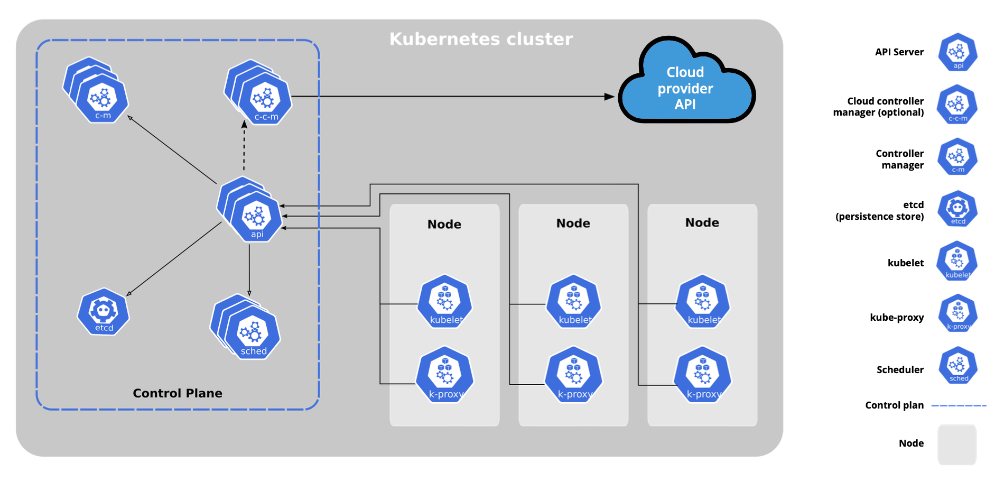Kubernetes Architecture
Introduction
Section titled “Introduction”In this chapter, we will explore the Kubernetes architecture, the components of a control plane node, the role of the worker nodes, the cluster state management with etcd and the network setup requirements. We will also learn about the Container Network Interface (CNI), as Kubernetes’ network specification.
Kubernetes Architecture
Section titled “Kubernetes Architecture”At a very high level, Kubernetes is a cluster of compute systems categorized by their distinct roles:
- One or more control plane nodes
- One or more worker nodes (optional, but recommended).

Control Plane Node Overview
Section titled “Control Plane Node Overview”The control plane node provides a running environment for the control plane agents responsible for managing the state of a Kubernetes cluster, and it is the brain behind all operations inside the cluster. The control plane components are agents with very distinct roles in the cluster’s management. In order to communicate with the Kubernetes cluster, users send requests to the control plane via a Command Line Interface (CLI) tool, a Web User-Interface (Web UI) Dashboard, or an Application Programming Interface (API).
It is important to keep the control plane running at all costs. Losing the control plane may introduce downtime, causing service disruption to clients, with possible loss of business. To ensure the control plane’s fault tolerance, control plane node replicas can be added to the cluster, configured in High-Availability (HA) mode. While only one of the control plane nodes is dedicated to actively managing the cluster, the control plane components stay in sync across the control plane node replicas. This type of configuration adds resiliency to the cluster’s control plane, should the active control plane node fail.
To persist the Kubernetes cluster’s state, all cluster configuration data is saved to a distributed key-value store which only holds cluster state related data, no client workload generated data. The key-value store may be configured on the control plane node (stacked topology), or on its dedicated host (external topology) to help reduce the chances of data store loss by decoupling it from the other control plane agents.
In the stacked key-value store topology, HA control plane node replicas ensure the key-value store’s resiliency as well. However, that is not the case with external key-value store topology, where the dedicated key-value store hosts have to be separately replicated for HA, a configuration that introduces the need for additional hardware, hence additional operational costs.
Control Plane Node Components
Section titled “Control Plane Node Components”A control plane node runs the following essential control plane components and agents:
- API Server
- Scheduler
- Controller Managers
- Key-Value Data Store
In addition, the control plane node runs:
- Container Runtime
- Node Agent - kubelet
- Proxy - kube-proxy
- Optional add-ons for observability, such as dashboards, cluster-level monitoring, and logging
Control Plane Node Components: API Server
Section titled “Control Plane Node Components: API Server”All the administrative tasks are coordinated by the kube-apiserver, a central control plane component running on the control plane node. The API Server intercepts RESTful calls from users, administrators, developers, operators and external agents, then validates and processes them. During processing the API Server reads the Kubernetes cluster’s current state from the key-value store, and after a call’s execution, the resulting state of the Kubernetes cluster is saved in the key-value store for persistence. The API Server is the only control plane component to talk to the key-value store, both to read from and to save Kubernetes cluster state information - acting as a middle interface for any other control plane agent inquiring about the cluster’s state.
The API Server is highly configurable and customizable. It can scale horizontally, but it also supports the addition of custom secondary API Servers, a configuration that transforms the primary API Server into a proxy to all secondary, custom API Servers, routing all incoming RESTful calls to them based on custom defined rules.